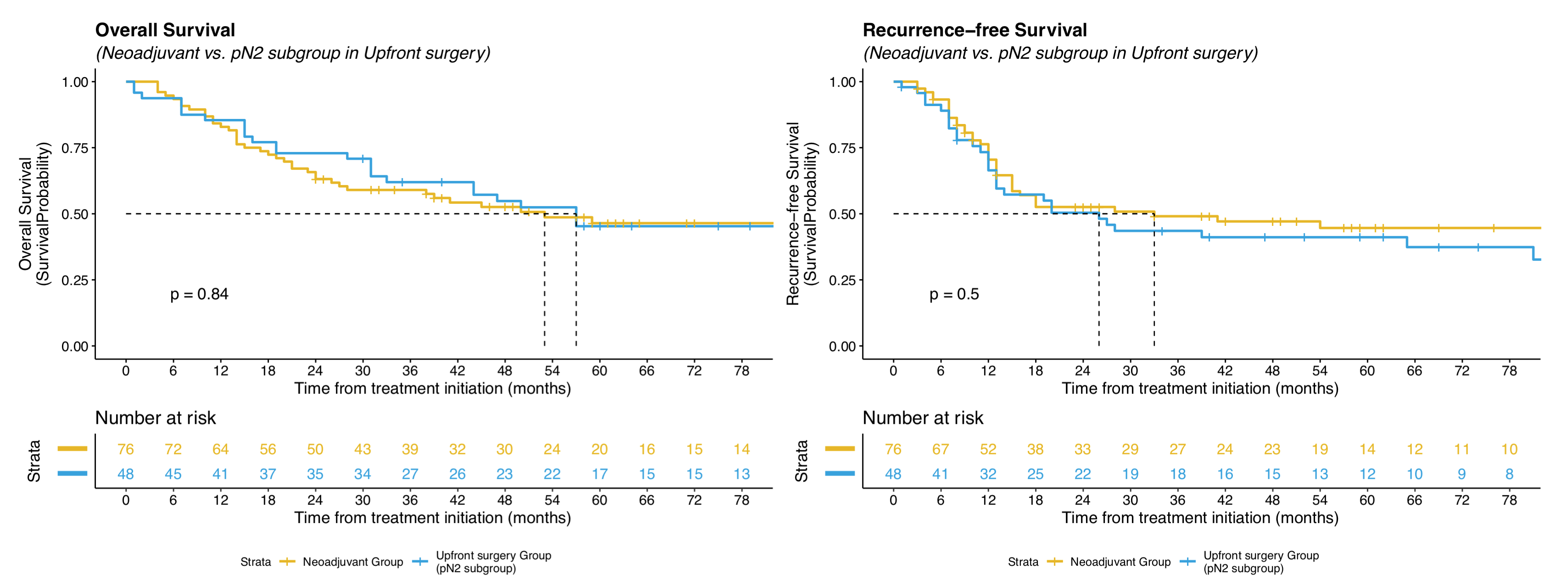초록접수 현황
| 19F-250 | 구연 미채택시 포럼 발표 |
Neoadjuvant Therapy Followed by Surgery Versus Upfront Surgery Followed by Adjuvant Therapy for Non-small Cell Lung Cancer Patients with Clinically Suspected Aortopulmonary Window Nodes
Junghee Lee, Sumin Shin, Jong Ho Cho, Hong Kwan Kim, Yong Soo Choi, Jae Ill Zo, Young Mog Shim, Jhingook Kim
Department of Thoracic and Cardiovascular Surgery, Samsung Medical Center, Sungkyunkwan University School of Medicine, Seoul, Republic of Korea
Purpose : Aortopulmonary window nodes (#LN5) and para-aortic lymph nodes (#LN6) cannot be accessed by routine mediastinoscopy or E(B)US-FNA, therefore separate surgical method is needed. Both neoadjuvant therapy followed by surgery or upfront surgery have been adopted as accepted strategy. We aimed to compare survival outcomes of each strategy.
Methods : Between 1994 and 2016, a total of 173 patients with left lung cancer and clinically suspected #LN5 or #LN6 metastasis were identified. Patients with suspected other N2 station, unexpected N2, and prior cancer history were excluded. Seventy-five patients underwent neoadjuvant therapy followed by surgery (neoadjuvant group) and the remaining 98 patients underwent upfront surgery followed by adjuvant therapy (upfront group).
Results : Clinical N2 disease were diagnosed using following method: CT or PET only (upfront versus neoadjuvant group, 28% versus 33%, p=0.513); VATS or anterior mediastinotomy (upfront versus neoadjuvant group, 15% versus 41%, p<.001). Histopathologic confirmation of #LN5 or #LN5 were made in 47% in neoadjuvant group. Neoadjuvant group had larger lymph nodes (median, upfront versus neoadjuvant group, 1.0 versus 1.3 cm, p<.001), and more positive PET uptake lymph nodes (upfront versus neoadjuvant group, 85% versus 97%, p=0.029). After surgery, 49% of upfront group revealed to have pathological N2 disease. Mediastinal downstaging had occurred 48% in neoadjuvant group. There were no differences in both overall (p=0.23) and recurrence-free survivals (0.26) between two groups as well as subgroup analysis between pN2 subgroup (upfront group) and neoadjuvant group (p=0.84 and p=0.5, respectively) (Figure).
Conclusion : Each therapeutic strategy is equally effective in terms of oncologic outcomes.
Methods : Between 1994 and 2016, a total of 173 patients with left lung cancer and clinically suspected #LN5 or #LN6 metastasis were identified. Patients with suspected other N2 station, unexpected N2, and prior cancer history were excluded. Seventy-five patients underwent neoadjuvant therapy followed by surgery (neoadjuvant group) and the remaining 98 patients underwent upfront surgery followed by adjuvant therapy (upfront group).
Results : Clinical N2 disease were diagnosed using following method: CT or PET only (upfront versus neoadjuvant group, 28% versus 33%, p=0.513); VATS or anterior mediastinotomy (upfront versus neoadjuvant group, 15% versus 41%, p<.001). Histopathologic confirmation of #LN5 or #LN5 were made in 47% in neoadjuvant group. Neoadjuvant group had larger lymph nodes (median, upfront versus neoadjuvant group, 1.0 versus 1.3 cm, p<.001), and more positive PET uptake lymph nodes (upfront versus neoadjuvant group, 85% versus 97%, p=0.029). After surgery, 49% of upfront group revealed to have pathological N2 disease. Mediastinal downstaging had occurred 48% in neoadjuvant group. There were no differences in both overall (p=0.23) and recurrence-free survivals (0.26) between two groups as well as subgroup analysis between pN2 subgroup (upfront group) and neoadjuvant group (p=0.84 and p=0.5, respectively) (Figure).
Conclusion : Each therapeutic strategy is equally effective in terms of oncologic outcomes.

책임저자: Jhingook Kim
Department of Thoracic and Cardiovascular Surgery, Samsung Medical Center, Sungkyunkwan University School of Medicine, Seoul, Republic of Korea
발표자: Junghee Lee, E-mail : ts.junghee@gmail.com








